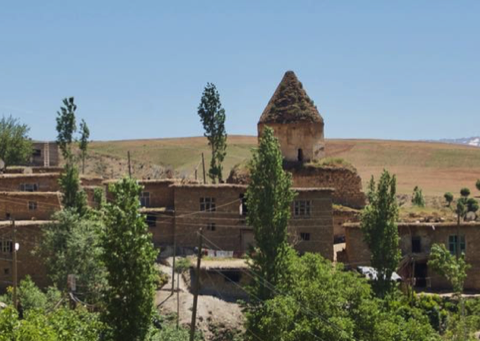Aparank, Hizan district, Bitlis

In the small village of Veras (new Turkish name Kayas*, former Armenian name Abarants or Aparank), in the SE of Bitlis province, the Monastery of the Holy Cross of Aparank was founded in the 9th century. The early history of the monastery is much better known than any other religious establishment in the region, because of the preservation of a history of its foundation written by the contemporary Armenian cleric Gregory of Narek.
A description from the 16th century shows that the monastery was then largely in decay. A century later an active abbot brought new life to the complex by repairing the main church and adding new buildings.
This how a British Consular Officer, Francis Crow, in 1897 described the Monastery and its surroundings:
“In a remote corner of South-Eastern Khizan, bordering on the Bohtan Mountains, and skirted by the river of that name, lies the old Armenian monastery of Surb Hatch or Holy Cross, picturesquely situated on the slopes of the Vanbier Dagh, under the shelter of one of its highest peaks. The monastery, which dates back to the twelfth century, is rich in arable and pasture lands, its corn-fields and meadows, pleasantly wooded, covering many acres of the mountain side down to the edge of the stream at its foot.... Pilgrimages were made to the building, and special religious services performed within the walls yearly, in the month of September, on a day set apart for that purpose in the Armenian calendar. The monastery and its church are much venerated by the Gregorian community, and in importance it ranks with that of Surb Carapet, in the western extremity of the Moush Plain.”
According to Crow the Deputy of the Bishop who resided in the Monastery left the place around 1891 due to the “poverty and the disordered condition of the country”. The Monastery was left to an Armenian caretaker, who cultivated the land with the aid of the Armenians of the adjacent village.
Crow relates that in 1895 a Kurdish ağa and his men settled in the village and compelled the caretaker and the other villagers “to embrace Islamism”. When the British traveller visited the village, the monastery was used as a barn by the ağa:
“The floor of the chancel and the nave are covered with heaps of of wheat and barley, and the side aisles blocked with stacks of hay. The vestments, vessels and other accessories have been appropriated by the Kurds, and the sacred books and archives partly destroyed, and the remainder given to the Kurdish children to play with.”